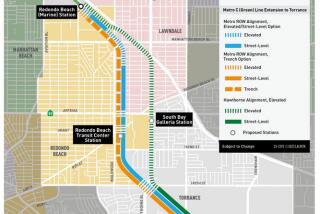Creative Solutions to Traffic Tie-Ups
- Share via
A series of articles recently appeared in local newspapers regarding the impending traffic gridlock we can all expect in the near future in South Bay. The articles prompted me to reflect, and I realized that the warning signals being given to the public were not being adequately balanced with creative solutions. As a public official, I understand that we cannot afford to be lackadaisical, for if we continue with business as usual, all of our communities will be choked with traffic.
Let us consider . . . the situation at hand. Federal funding problems have forced the Southern California Rapid Transit District to come to terms with its service problems. They have sought to improve the public’s awareness by dividing the county into “corridor regions,” and in each corridor created policy committees made up of local elected officials as well as technical committees made up of professional staff. While I find the approach of complementing staff with policy makers in a regional area heartening, it also tends to perpetuate the fragmented approach taken to the transportation issue. The question should not be, “How can we save specific RTD lines from devastating funding costs?” but rather, “How can we as a region better utilize less public financing to improve our overall transportation system?”
The point being made here is that the problem transcends the RTD’s and other transit systems’ bureaucratic territoriality. It goes beyond each community’s parochial interest in retaining as much Proposition A funding as they can. (Proposition A is the half-cent sales tax imposed in 1980 to fund transit projects. A portion of the fund is returned to cities, while the rest is being used to subsidize bus fares and build a rail transit system.) An organizational device must be created to stress the regional and systemic nature of the problem. Increasing density leads to increased traffic, and traffic, like air and water, goes beyond the border of a political jurisdiction.
The decision makers allow and encourage development without fear of being held accountable for its consequences. Each housing project, shopping center and new office building looks fine on paper when one considers each of them singularly. Taken together, as reality dictates, we find that (their) impact is regionally devastating and threatens the “good life” we have come to expect from this area.
Proposition A held out lots of promises to the public. However, a half-cent spread in so many ways to placate so many interests has caused the public to lose faith in our ability to deliver. The federal government, which has its own problems, is obviously not wholeheartedly in support of the massively expensive heavy-rail system being proposed in this county, nor does it seem prudent to install a light-rail system along a route from Long Beach to Los Angeles, which is questionable in terms of the number of riders.
I understand that we must start somewhere, but I am concerned that a combination of potential cost overruns on one system and less than optimum patronage on the other could permanently injure our ability to garner support for future projects.
What I propose is that we consider more innovative and less obtrusive techniques in delivering mass transit. We now know that a major merger between railroads is taking place. The public and private sector need to combine efforts in retaining these invaluable rights of way for transit purposes. We must also diligently explore uses of other rights of way (such as flood-control channels) as well. The mode utilized should be Spartan in costs, easily operationalized, and able to be added incrementally as the need arises. There are light-rail vehicles available which fit these criteria, are relatively inexpensive and are diesel-powered.
Rather than looking for exorbitant or exotic cure-alls, we must endeavor to utilize the resources at hand. Again, it cannot be done by any one agency or by any single political entity. It requires instead a mandate for policy makers and the private sector that benefits the most to jointly come to grips with the transportation issue.
JAMES W. CRAGIN
Gardena city councilman
More to Read
Sign up for Essential California
The most important California stories and recommendations in your inbox every morning.
You may occasionally receive promotional content from the Los Angeles Times.










